Day Two: Scientific truth meets art
Mary Warner Marien in our Photography II book, Photography, A Cultural History and Lucy both described Hippolyte Bayard:
Hippolyte Bayard (1801-1887) attempted to deduce Daguerre's process before the specific information was released to the public. Bayard aimed at making a direct positive print, such as that produced by Niepce and Daguerre, but one that he and others considered to be simple and elegant. Bayard completely darkened light-sensitive paper that had been soaked in sodium chloride by exposing it to light. He then took the blackened paper and soaked it again, this time in a solution of potassium iodide. When this paper was placed in a camera obscura and exposed, the light bleached the paper according to its intensity. Like the daguerreotype, Bayard's unnamed process produced a single, unique print that coudl not be used as a negative to make copies. Bayard attempted to join in Daguerre's momentum by showing his prints to Arago a close friend of Daguerre's. Arago paid Bayard to keep researching and not publish his work. Bayard never received as much interest as Daguerre did and in response made a Self-Portrait as a Drowned Man.1
Below: Hippolyte Bayard's Self-Portrait as a Drowned Man

Below: Portrait of William Henry Fox Talbot
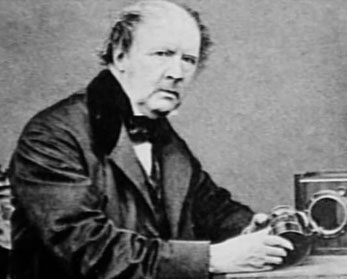
- William Henry Fox Talbot
1841 received a patent for the Calotype process.
William Henry Fox Talbot was the inventor of the negative / positive photographic process, the precursor to most photographic processes of the 19th and 20th centuries. He was also a noted photographer who made major contributions to the development of photography as an artistic medium. His work in the 1850s on photo-mechanical reproduction led to the creation of the photoglyphic engraving process, the precursor to photogravure. Talbot is also remembered as the holder of a patent which, some say, affected the early development of commercial photography in Britain. Additionally, he made some important early photographs of Oxford, Paris, and York2
Frustrated with the camera lucida and camera obscura. These thoughts in turn prompted Talbot to muse "how charming it would be if it were possible to cause these natural images to imprint themselves durably, and remain fixed upon the paper." "And why should it not be possible?" he asked himself. Talbot jotted down thoughts about experiments he could conduct at home to see if Nature, through the action of light on material substances, might be brought to draw her own picture.3
Within a few months, he began to experiment with the idea that a sheet of fine writing paper, coated with salt and brushed with a solution of silver nitrate, darkened in the sun, and that a second coating of salt impeded further darkening or fading. Talbot used this discovery to make precise tracings of botanical specimens: he set a pressed leaf or plant on a piece of sensitized paper, covered it with a sheet of glass, and set it in the sun. Wherever the light struck, the paper darkened, but wherever the plant blocked the light, it remained white. He called his new discovery "the art of photogenic drawing."
One reason Talbot patented the calotype was that he had spent many thousands of pounds (a fortune) on the development of the calotype process over several years. It is also significant that, although the daguerreotype process was supposed to be free to the world, Daguerre secured a British patent on his own process making it illegal for people in Britain to practice his process without a license. The purpose behind this patenting in Britain is not clear, but perhaps it was to stop Talbot from claiming priority or developing his system against Daguerre. Talbot's negative/positive process eventually succeeded as the basis for almost all 19th and 20th century photography. The daguerreotype, although stunningly beautiful, was rarely used by photographers after 1860, and had died as a commercial process by 1865.
The calotype was a refinement of his earlier photogenic drawing process in the use of a developing agent (gallic acid and silver nitrate) to bring out a latent negative image on the exposed paper. The negative meant that the print could be reproduced as many times as was required. Daguerre's Daguerreotype was a direct positive process and not reproducible.
Below: Latticed Window at Lacock Abbey made in 1835 a print made from the earliest surviving negative
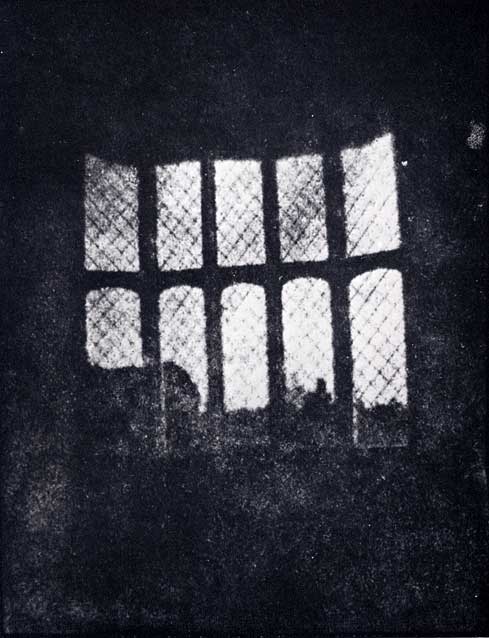
- The Calotype/photogram
Although such photogenic drawings were beautiful as objects and useful as scientific records, Talbot knew that a fast, permanent, and accurate means of producing photographic images in the camera was the true brass ring, and on September 23, 1840, he found a way to seize it. Talbot discovered that an exposure of mere seconds, leaving no visible trace on the chemically treated paper, nonetheless left a latent image that could be brought out with the application of an "exciting liquid" (essentially a solution of gallic acid). This discovery, which Talbot patented in February 1841 as the "calotype" process (from the Greek kalos, meaning beautiful), opened up a whole new world of possible subjects for photography.4
With all the pieces of a workable process now in place,
Talbot set out to promote his invention at home and abroad. He traveled to Paris in May 1843 to negotiate (unsuccessfully) a licensing agreement for the French rights to his patented calotype process and to give firsthand instruction in its use. At home, he demonstrated the commercial viability of his invention by means of a photographically illustrated book, The Pencil of Nature, published in parts beginning in 1844. In less than a decade, Talbot conceived and brought about a wholly new way of making pictures, perfected the optical and chemical aspects of photography, and learned to use the new medium to make complex images for the botanist, historian, traveler, and artist.5
While it was never remotely competitive in the commercial sphere (although Talbot and Nicolaas Henneman (1813-1898) used it as the basis of their photographic business at Reading), it was offered as the chief alternative to the Daguerreotype and was more attractive to amateurs, artists, and scientists, who adopted it widely. In France too it was taken up with enthusiasm: the pioneer photographer Hippolyte Bayard (1801-1887) preferred it to his own inventions and Louis-Désiré Blanquart-Evrard (1802-1872) adopted it in 1844, beginning experiments with the calotype process that would lead to the development of albumen paper prints by 1850.
The Calotype proper is a negative image (along with its offshoot the waxed paper negative), although its positive counterpart, the salted paper print, is the more common form in which it is encountered. Calotypes are made by brushing the best quality drawing or writing paper with a solution of silver nitrate, drying the paper, and then immersing it in a solution of potassium iodide to form a light-sensitive layer of silver iodide. Immediately before use the surface it treated with 'gallo-nitrate of silver' (a mixture of silver nitrate solution and gallic acid) to act as an accelerator. Exposure in a camera, where the paper must be held in a dark slide, produces a latent (invisible) image which is developed by washing in gallo-nitrate of silver, fixed in hypo and thoroughly washed. The translucency of Calotypes can be improved by waxing, and a positive can be made by repeating the original process or by 'printing out' the image in much the same way as making a Photogenic Drawing. When toned, in, for instance, gold chloride solution (to give it a purpleish tone), a positive produced in this way is known as a 'salted paper print'.
Below: photogenic Calotype

- Sir John Herschel
Below: portrait of Sir John Herschel
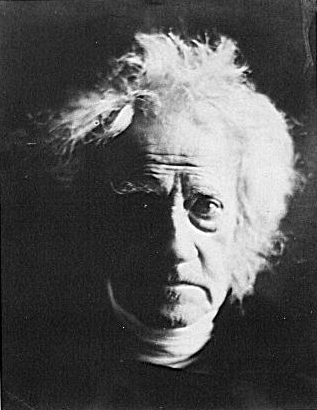
The name "Photography" is attributed to Sir John Herschel , who first used the term in 1839, the year the photographic process became public. The word is derived from the Greek words for light and writing.
Talbot's early photogenic drawings, such as those in the Bertoloni Album, with their shades of lilac and lavender, remained fugitive, for they were only partially stabilized with a solution of salt. A more permanent means of "fixing" the image with hyposulfite of soda was proposed by Talbot's friend the eminent scientist Sir John Herschel; "hypo" was adopted by Talbot for most prints beginning in the early 1840s and is still used today as a fixer for black-and-white photographs.
Herschel's photographic investigations continued into the 1840. He experimented with the possibilities of color photography, using vegetable dyes; he also used iron salts to create a process he dubbed cyanotype, which produced an image in which the dominant tones were deep Prussian blue and white.
Herschel was one of the first to voice the democratic potential of photography; of the cyanotype he wrote that every person might be a printer and a publisher.
Below: an early cyanotype by Sir William Henry Herschel

With the exception perhaps of the waxed paper process, which was invented in 1851 by Gustave Le Gray (1820-1882) and extended the life of paper negatives in the 1870s, the first generation processes - the Daguerreotype, Photogenic Drawing and Calotype - were all extinct by the end of the 1850s, having given way to their own offspring: the wet collodion glass negative and the albumen print.6
Below: The Broom : first "artistic" photography outside of portraiture
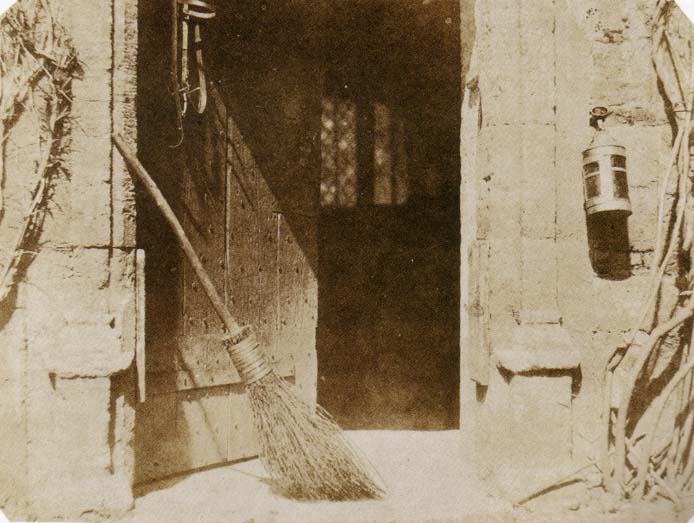
Below: Talbot's Earliest Surviving Paper Negative: Latticed Window, Lacock Abbey
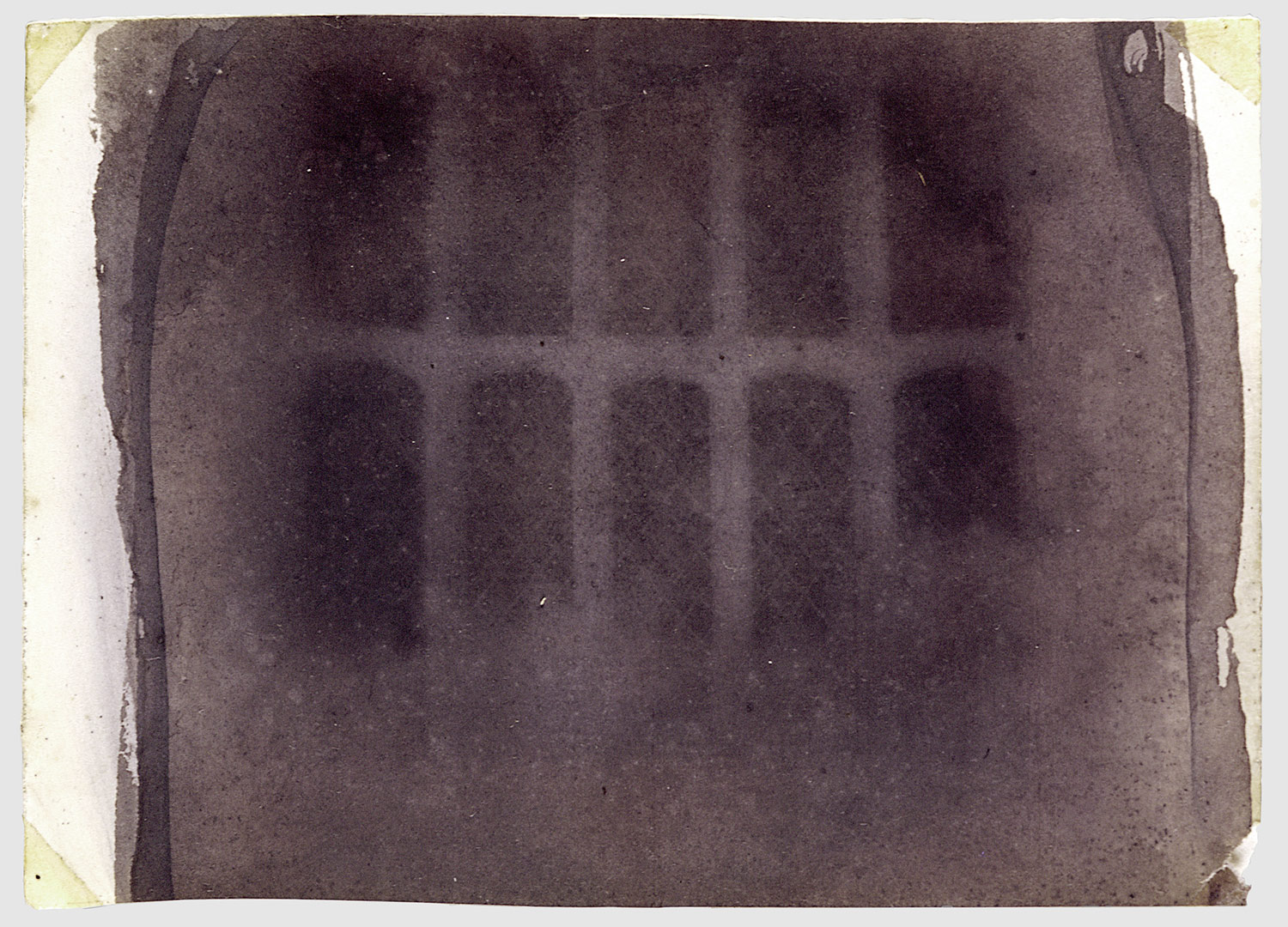
Below: Talbot's Calotypes of lace

Below: Talbot Pencil of Nature Plates
//www.vam.ac.uk/images/image/46351-large.jpg
- Photography as an art form
John Lienhard of Houston University said, " But, what is life without that dark side? Talbot put that fact in special focus when he created modern film photography — when he showed us reality only after first catching it in its negative form."7 Talbot would open Pandora's box by taking the first artistic photograph.
- The Wet Collodion Glass Negative & Albumen print
The calotype, despite waxing of the negative paper to make the image clearer, still was not pin sharp like the metallic daguerreotype as the paper fibres degraded the image produced.The problem was resolved in 1851 (the year of Daguerre's death) when the wet collodion process enabled glass to be used as a support, the lack of detail often found in calotype negatives was removed and pin sharp images, similar in detail to the daguerreotype was created. The wet collodion negative not only brought about the end of the calotype in commercial use, but also spelled the end of the daguerreotype as a common process for portraiture.
Below: "Valley of Yosemite" a wet collodion print by Eadweard J. Muybridge
![]()
Richard Beard
Southworth and Hawes
Hippolyte Bayard
Julia Margaret Cameron
Perfect imitation of reality.
Talbot
Calotype paper versus daguerre one of a kind
technical processes
printmaking
light sensitive emulsion
oil paper down
Talbot Herschel
Talbot's botanical specimens

Relationship between science and photography
Herschel philosophical
origin of species









